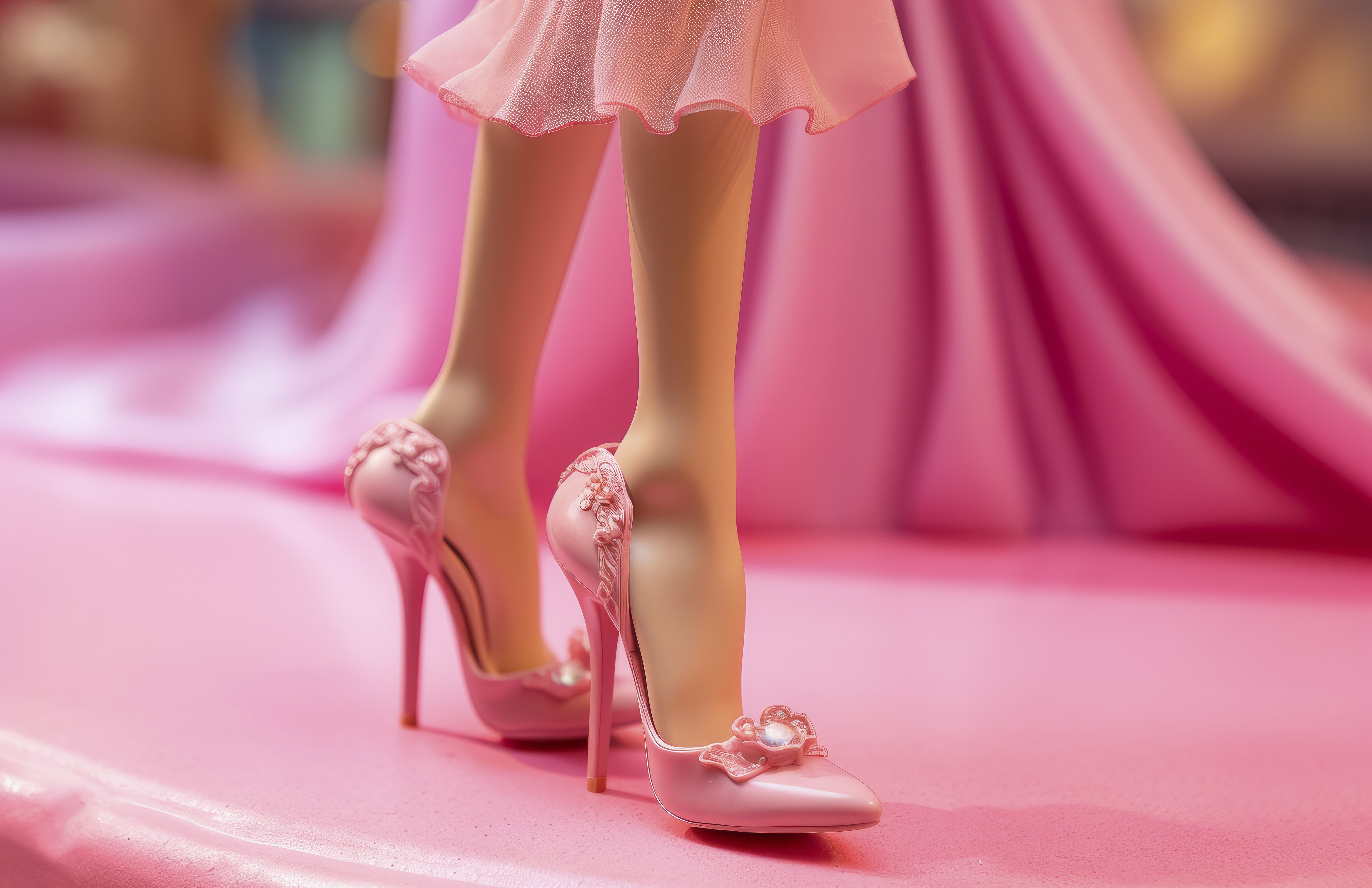The (Never-)Ceasing Pink Wave: From the Plastic Playhouse to Nostalgia Marketing

In almost every attic you can find long-forgotten dolls that evoke nostalgic childhood memories. However, only one doll can boast of having taken over the world and painted it pink – Barbie. How did this plastic doll become a global phenomenon, a feminist icon, and a pop culture symbol that influenced the mass marketing revolution?
A single remarkable idea has the potential to revolutionise an entire industry, inspire millions of children, and become one of the world’s most beloved toys. The creation of Ruth Handler (1916–2002), the founder of Mattel, the largest toy company in the US today, achieved precisely this global sensation status. It was inspired by her daughter, Barbara (who continued the work her mother Ruth had initiated after her passing), who played with paper dolls. The resulting creation, known as Barbie, was, as R. Gerber (2010) has argued, a beauty that nobody wanted at the time.
During the 1950s and 1960s, the toy industry was primarily dominated by men, and traditional dolls were designed to resemble babies, ostensibly to prepare girls for motherhood. Introducing a toy in the form of an adult woman’s body to the market posed a significant challenge, prompting Ruth to take a bold and unconventional step to bring her idea to life. Despite facing criticism and sceptical comments from industry experts, Ms Handler, who possessed excellent management skills, firmly believed that girls needed a doll that would enable them to envision a future filled with professional achievements, adventures, and unexplored opportunities. Recognising a market gap at the time and employing innovative marketing strategies such as telemarketing, Mattel embarked on a journey of expansion. After investing in the popular “voice box mechanism” technology, which had also been integrated into other toys, she launched the “Mickey Mouse Club” TV series, providing a national platform for Barbie (Gerber, 2019).
Barbie’s pink wave might have receded if it weren’t for Ruth’s expertise in organisational theories, her successful company restructuring and expansion, and her adept adaptation of various business models. These achievements solidified her position as one of the most successful leaders in the industry. The ability to anticipate and respond swiftly to a changing environment, foresee and manage potential risks, and, above all, personal ambition, determination, and strategic investments in other toy companies, have not only brought global recognition to Mattel but also elevated the status of Barbie.
and her adept adaptation of various business models. These achievements solidified her position as one of the most successful leaders in the industry. The ability to anticipate and respond swiftly to a changing environment, foresee and manage potential risks, and, above all, personal ambition, determination, and strategic investments in other toy companies, have not only brought global recognition to Mattel but also elevated the status of Barbie.
Did you know that since 1959, over 96,000 kilometres of fabric have been used to create outfits for Barbie and other doll characters (Forbes, 2009)? That’s enough fabric to encircle the Earth’s surface twice or to host the longest-running fashion show. Indeed, close collaborations with top designers, world-famous celebrities, high-profile influencers, and prestigious brands like Dior, Versace, Chanel, Gucci, Ralph Lauren, and many more have been key to Barbie’s success, paving the way to the global market.
The universally beloved Barbie boldly entered children’s favourite TV shows as well. As early as 1987, Mattel made its television debut with a unique animated series titled “Barbie and the Rockers”, which reflected the pop music trends of that era. This proved to be one of the most successful marketing strategies, resulting in a significant surge in doll sales. Just a few decades later, in 2008, Barbie had her very own dedicated interactive television channel, “The Barbie Channel”. This channel offered on-demand videos, interactive voting, and various games. The channel is estimated to have reached an audience of over 19 million viewers, and its interactive content was subsequently integrated and distributed on the official “Barbie” website (Wherry & Schor, 2015:182). Soon after, in 2012, “Barbie” also successfully garnered 11.5 million subscribers on YouTube, diversifying its advertising channels.
Competitors did not anticipate Mattel’s remarkable success, nor did they expect Ruth Handler’s bold ideas to endure to this day. The timeless tale of Barbie mirrors the dreams, desires, and ideals of young people, and Mattel has adeptly maintained its relevance and significance in a shifting society by consistently updating universal generational values. But can this go on forever? That is a question your child, colleague or neighbour could answer as they set off in a pink tie on Wednesday evening for the long-awaited world premiere of “Barbie”. It is a film based on Mattel dolls who embark on a journey of self-discovery and... become human? That’s right! For the first time in Barbie’s history, a doll becomes a human being, allowing us to see Barbie not only as an idealised icon but also as a person facing real-life problems and crises. This metamorphosis has only heightened Barbie’s influence: it resonated with the younger generation of viewers and invoked a sense of nostalgia for the older generation, flooding them with memories.
Nostalgia is not just a universal sentimental longing for the past; it is also a potent marketing tool employed by many companies to establish a robust emotional connection between the brand and the consumer, fostering increased consumer engagement and loyalty. It is often the case that positive emotions, credibility, self-connection, sensory experiences, etc. offered by companies do not entirely meet consumers’ expectations. Various reasons may prevent the consistent delivery of such benefits. To establish a distinctive connection with consumers, companies go through various stages of building relationships. A compelling example today is Mattel, which has progressively expanded its audience alongside Barbie, crafting a shared narrative by keeping it current. How did they achieve this?

Ruth Handler was one of the few women of her time who could boast exceptional managerial talent. She understood her customers’ needs, closely monitored the market, and when she identified weaknesses, she promptly leveraged them to her advantage. When the first Barbie was introduced to the world, consumer feedback was taken into account, and new components were gradually introduced to the market to complement the narrative created by the main character. Girls who played with Barbie wanted a male counterpart for the doll. In 1961, Mattel introduced Ken. The demand for a couple’s setting emerged, leading Mattel to introduce Barbie’s dream house, in line with architectural trends of the time. Over time, these components have evolved, new characters have emerged, the dream house has expanded and been modernised, and Barbie’s story has continued to captivate the world. In this manner, Mattel has not only forged a genuine connection with the younger generation by providing them with innovative technological solutions but has also successfully added significant economic value to its products.
While there is a real hunt for Barbie products at auction, buyers often compete so fiercely that prices can rise from a few to several hundred thousand euros in an instant. The doll is also attracting attention on social networks and in the press. Many argue that Barbie’s unprecedented marketing campaign stands as one of the most extravagant and costly endeavours in the history of cinema. From dominating Google search engines to inspiring unique shoe collections, the entire world has turned pink! Established partnerships with a diverse array of companies, a genuine and enduring connection with consumers spanning generations, and an empowering message that has resonated with millions: dream boldly, do what you want, and be who you want to be. Undoubtedly, the doll’s influence extends far beyond the shelves of toy shops. The real lives of stars are often intertwined with fiction, resulting in numerous similarities and differences between the two worlds. This creates a unique experience for cinema audiences. The film’s ambassadors include not only the lead actors, the world-famous Margot Robbie, Ryan Gosling, and Issa Rae, but also renowned singers, such as Dua Lipa, Billie Eilish, Sam Smith, and others. They composed the film’s main soundtrack, which was released as an album featuring songs that have topped the charts on leading radio stations.
Breaking free from fiction and venturing into reality, Barbie takes yet another bold leap – this time into virtual reality. Embracing cutting-edge technology and riding the wave of popular trends, Warner Bros showcases the power of artificial intelligence with the introduction of the Barbie Selfie Generator. This innovative tool can transform users’ selfies into movie posters for the film “Barbie”. In other words, consumers become co-creators of the story, which is one of the most impressive elements of the film’s marketing. It is a perfect illustration of how creativity and technology can effectively complement each other, creating new opportunities to build brand image and strengthen the relationship with consumers.
Observing this successful symbiosis between technology and creativity, there’s no doubt that it is not merely a technological marvel; it is the outcome of a cohesive marketing strategy and daring decisions. From Europe to Australia, from the Middle East to Alaska, Barbie fever has swept across continents, inspiring children to explore their identities, craft unique narratives, and engage their imaginations in journeys through time. Regardless of race, age, language or religion, each Barbie conveys a message of unity through cultural diversity, encouraging us to seek understanding and dismantle society’s entrenched stereotypes at every cultural point of contact.